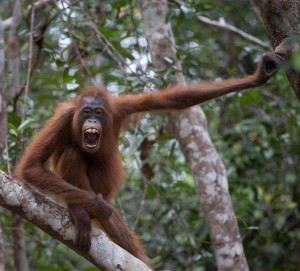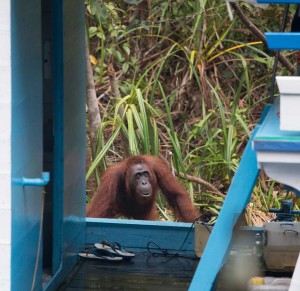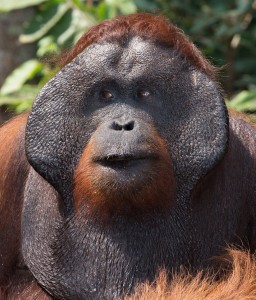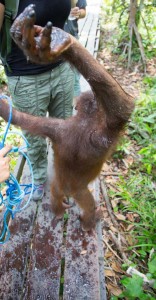Dateline: October 2012
In 1991 I went to Borneo to work with the orangutans in the rain forest at Tanjung Puting National Park. It was a fascinating trip that I have chronicled on this web site already. Reading about this prior trip will allow you to get a good perspective when you read this page on my recent trip. You can access my 1991 trip by clicking here.
Hard to believe it has been several decades since I examined this little guy, or should I say, he examined me!
In 1991 I never dreamed I would go back, so my trip in October of 2012 was part nostalgia and part new adventure. I am glad I went back to see the changes and experience it all over again.
What I encountered on this trip were a group of dedicated individuals taking action to help this highly endangered species. Most were local Indonesians, the rest were volunteers from all over the world. They are putting forth substantial time and effort to save the orangutans in the face of strong palm oil and timber interests that are devastating the forest and all the creatures that live there. The future for these creatures is not good and they need help from all of us.
Since several people have asked, this is the same place that Julia Roberts went to in 1997 when she made her Camp Leakey video seen on TV. The dominant male at that time, who physically accosted her, was Kusasi. You have to wonder why the director let her get anywhere near this powerful animal and risk physical injury.
Present day Borneo
Borneo, the 3rd largest island in the world, is made up of 3 countries; Brunei, Malaysia, and Indonesia. Indonesia is the largest of these 3 countries. The Indonesian part of Borneo is also known as Kalimantan. We were in the southern part of Kalimantan near a town called Pangalan Bun. We stayed with a Dayak family just outside of Pangalan Bun in a smaller town called Pasir Panjang. We stayed here because it was across the street from the Orangutan Rehabilitation and Care Center, and we could literally walk there in 5 minutes.
Since I sometimes get blank stares when I tell people I went to Borneo. Here is a big picture map for the geographically challenged!
Borneo is on the equator, so there are no seasons like we are used to (except rainy and rainier), and it is hot and humid all the time
This map shows the 3 countries that make up Borneo. The green arrow in Tanjung Puting National Park points out where we spent all of our time
This map shows more details of the area and Tanjung Puting National Park:
From Jakarta we flew into Pangalan Bun (you can see the airport symbol).
We stayed at a house in Pasir Panjang (PP on the map) for 2 weeks
I took 2 boat rides up the Sekonyer river, past 2 Feeding Stations (FS) and all the way to Camp Leakey (CL)
In Borneo you will encounter many Dayaks, people that have a profound understanding of the rainforest. All are exceptionally friendly. When walking down any street they will shoot past on their scooters (sometimes a family of 4 is on one of these scooters) and yell “hey mister”. It does not matter whether you are male or female, everyone gets the “hey mister” scoot-by. Click on the 6 second video below for an idea of how friendly they are as we walked around.
Some things in Borneo are a constant over the decades:
- You better like rice because it is served at almost every meal
- You will be barefoot when indoors (and most of the time in general) because all shoes are kept outside
- It is hot and humid all the time, so plan on being wet or damp continuously. Your body will start adjusting within a few weeks, although it is draining, and you will move slower just like the local people.
- Its better to be there in the dry season (late spring to early fall) because there are less mosquitoes, less leeches, and less water to slosh around in when walking in the jungle. On my current trip there was a drought during the summer so we encountered few mosquitoes, which means less chance of exposure to malaria.
- You are on the equator, so bugs will be a part of your life. They are a fascinating part of life on this planet if you are not squeamish. Do not go to the equator if you find insects icky.
This praying mantis found our fan a convenient place to hang out one night
- Scooters are the mode of transportation. They drive on the left, although they are reasonably conservative drivers, far removed from drivers in Naples, Italy, where driving is a high speed video game.
- Fuel is rationed due to a lack of refining capacity, so lines at gas stations are long, and it can take up to 2 hours to fill a small scooter tank.
- Prices are very inexpensive compared to what we are used to. An hour at an Internet café when we tried to reschedule our flights cost only 40 cents. The room at Pak Sia’s house, which included 3 meals per day, was $100 per person for 2 weeks.

Pasir Panjing is populated mostly by Dayaks, almost all of whom are related. Whenever any community event is involved everyone is invited, including us. In our 2 weeks we went to two going-away parties and one wedding. Children can walk the dark streets at night without any concern.
We stayed at Pak Sia’s house in Pasir Panjing and were welcomed like we were family.
Pak Sia welcoming us with refreshments upon our arrival
His family welcomes worldwide volunteers that work at the Care Center across the street. These are usually young students or young conservationists, paying for this on their own, so Pak Sia charges them a minimal price for room and board.
His knowledge of the area and the orangutans (he can look at a picture of any orang from decades ago and tell you its name) is impressive
Being a veterinarian, and having been there before, I had access to orangutans at the Care Center that is not available to most people. This page will show you many pictures of orangutans in the wild and at the Care and Rehabilitation Center outside the park. Pace yourself, because there is a large amount of information on this page if you follow all the links.
For kicks I will at times contrast photos from my most recent trip to those in 1991. This will give you a good idea of the quality of digital cameras, and illustrate the changes that have occurred over 21 years.
This extensive page has many photos broken down into several major summary sections. Within each of these major sections are links to much more detail on that section:
- Do you really want to fly this far?– the logistics of getting in and out of Borneo
- Klotok ride upriver– taking a boat into the rainforest and seeing the wildlife along the way while visiting feeding stations. This section has a special link on the proboscis monkeys and the gibbons, two other primates in the area.
- Camp Leakey– the final destination on the klotok ride where Dr. Galdikas did her seminal work, and where I spent all of my time over 2 decades ago
- Doyak and Tom– the dominant males that hang around the feeding area
- The Orangutan Care and Rehabilitation Center– do not miss this section. Make sure you click on the links for additional photos if you want to see babies, babies, and more babies.
- Orangutan Foundation International– how to contact them for more information on how you can help the plight of the highly endangered orangutans
This time I brought professional digital camera equipment that was not available in 1991. For you photo fans here are my tools:
- Canon 5D Mark III- used for most of the static photos, especially the babies at the Care Center and some of the orangs at the feeding stations
- Canon 1DX- used on the klotok ride upriver, the feeding stations, and any time I anticipated action shots. I paid off when shooting the proboscis monkeys jumping from tree to tree.
- Canon 24-105 MM IS lens- used mostly with the 5D Mark III, and mostly at the Care Center and somewhat at the feeding stations
- Canon 70-200mm F/4 IS lens- used mostly with the 1DX at the feeding stations and on the klotok shooting wildlife along the river
- Canon 100mm macro with ring flash- used mostly with the 5D Mark III for portrait and insect shots
- Canon 400 mm f/5.6 lens- used on occasion and with both cameras to shoot wildlife
- Canon 1.4X teleconverter- used on the 70-200mm f/4 IS with the 1Dx on the klotok rides
Do you really want to fly this far?
Getting there is an adventure in itself. Borneo is over halfway around the world from California. This is the second time I have flown Cathay Pacific and I find them to be outstanding. The flight leaves Los Angeles at 1:30 AM and arrives in Hong Kong 14 hours later (don’t forget you cross the international date line and lose a day).
Even though it is midnight at LAX, the anticipation of our upcoming trip has us smiling for this photo. From left to right my travel companions are Jade Chang, Ann Ichikawa, and Natalie Hipskind.
The airport in Hong Kong is beautiful, busy, modern, and filled with high end perfume and clothing stores. When you arrive you walk past a nurse with a surgical mask holding a thermometer. She is there to take your temperature if you want. Interesting custom to say the least.
After a 3 hour layover in Hong Kong its another 5 hour flight to Jakarta. We spent the night at the Sheraton in Jakarta before continuing on to Borneo and Pangalan Bun the next day.
We had an interesting time finding the gate to our flight from Jakarta to Pangala Bun then next day. We had an even more substantial problem when our flight back two weeks later was cancelled. For more details on this and to understand how crazy things can get in Borneo, click on this link.
Klotok ride upriver
Even though we stayed at Pak Sia’s house directly across the street from the Care Center, we did not go to the Care Center for 5 days due to quarantine protocols. We took advantage of the time and took a 3 day klotok ride up the Sekonyer river to Camp Leakey (I took a second klotok ride a week later). This camp is where I spent all of my time when I was last here 21 years ago to the month.
Taking a klotok upriver is the usual trip for most tourists to watch the semi-wild orangutans being fed and see the wildlife along the river. Many tourists from all over the world take the klotoks up the Sekonyer river to Camp Leakey. Even though it is touristy, the 2 night 3 day trip is worth it, and a must see for any trip to Borneo.
My klotok in 1991 as we left the port of Kumai and approached the Sekonyer river mouth
The current ones are bigger and nicer
The wildlife along the Sekonyer river are elusive and move very rapidly. I had to be in front, on the alert, and ready to shoot, to be able to capture the photos you will see on this page.
An interesting animal we saw along the river was the proboscis monkey
Beautiful bird life abounds along the river, including this stork-billed kingfisher
You might even get to pull the tail of a long-tailed macaque as you motor slowly by in the klotok
This is your first chance to see a semi-wild orangutan
When an orangutan approaches keep an eye on your possessions, because their philosophy is “what is yours is mine”
As the sun sets you get your chance to see the flying foxes (huge bats) and even get a firefly show
Camp Leakey
In 1991 I spent all of my time at Camp Leakey and did not go to the Care Center. Much has changed since then, and even though research is ongoing, it is geared more towards ecotourism. It is quite popular for tourists to watch a feeding put on by the park service at the feeding stations.
That platform in the distance is the current entrance to Camp Leakey
The welcoming committee on the dock at Camp Leakey in 1991
The greeting this time was a little more vocal
Keep an eye on those guys in the hairy red outfits- they are sneaky! Oh sure, they look innocent hanging on to a tree and pretending not to notice you.
They wait patiently, and when you are distracted they execute their plan
While you are looking for your camera they make their move….
….and run behind the klotok
…..and scope out where the pineapples are located
They are career thieves, and the getaway only takes a few seconds
Another group of of sucker tourists robbed by the “pineapple bandit”
Click on the photo below to see lots more of Camp Leakey and the orangutans that are there
Doyak and Tom
Over the course of 2 klotok rides I encountered the 3 dominant (and rival) males in the area; Yani, Tom, and Doyak. We spent the most time with Doyak at a feeding station, although we had an encounter with Tom who decided he did not want us in his territory. We saw Yani as we walked past him while he shook a branch at us in defiance.
This is Doyak. Click on his photo below to see him in action at the feeding station
This is Tom, click on his picture for more pictures and even a video of him escorting us out of Camp Leakey
Orangutan Care and Rehabilitation Center
The orangutans at the care center range from young to old, and are here for a multitude of reasons. Some have chronic disease and will not survive in the wild. Others are orphans and need a place to call home in the deforested rainforest. Many are only a few years of age. Their mothers were killed because they wandered into the wrong area (usually a palm oil plantation), or their mothers were killed because some citizen wanted a baby orangutan in their house (which is illegal). When this baby is discovered (usually a neighbor rats them out) it is confiscated by the authorities and brought to the care center. The Care Center is not open to the general public.
Some of the babies here are so young they are still in diapers
The dedicated workers are intimately familiar with every baby
They are taken into the forest often to practice their orangutan skills and hopefully be released back into the rainforest
Its fun to hang with them in the forest and watch them play
This is also where they hone their robbery skills for when they graduate to stealing pineapples. They consider any of your possessions to be theirs-you have been warned!
At this stage in their career they start with water bottles. A water bottle is never safe around them, no matter how secure it is in your backpack.
All they want is the pleasure of bursting your water bottle open in front of you
The goal of this game is not to drink the water, but to tease you into thinking you can get the bottle back
You better be good at climbing trees if you want to get the bottle back
They have strong clinging instincts and are quite powerful for their size when they don’t want to let go. This one was just bottle fed and decided she was not going to let me get away.
Its an understatement to say that working with these babies is an unbelievable experience
This picture reminds me of one from my first trip
If you are ready for lots more baby pictures, including videos of them in full baby mode, click here and hang on to your possessions.
Some of our group at a going-away-party for the lady in the center who had been volunteering for 6 months. Hopefully we will all meet up again some time!
Orangutan Foundation International (OFI)
It is run by donations and always in need of monetary support to help fend off the palm oil and timber interests. Click on this link to learn more about them and how you can help.
If you have a group that wants a personal slide show on this trip, with photos in much higher resolution than can be shown on this web site, call or email:
562-434-9966
vet@lbah.com
Return to Wildlife Photography Page
















































